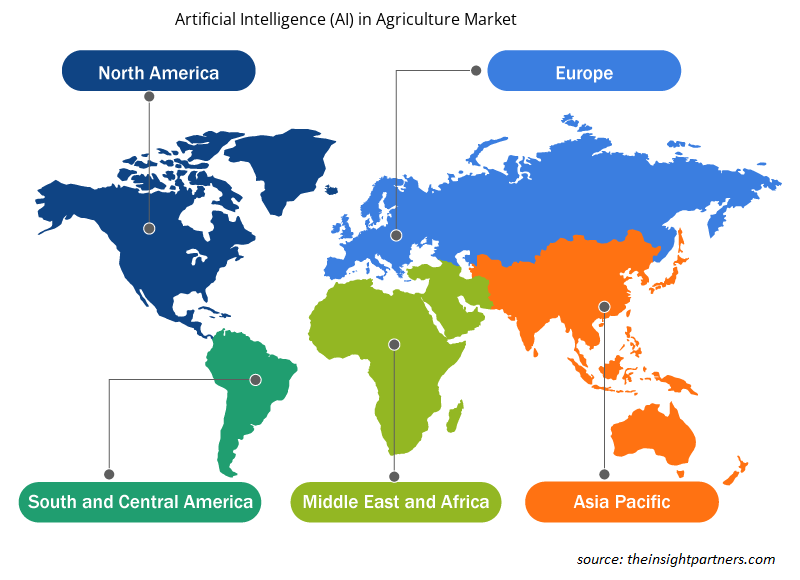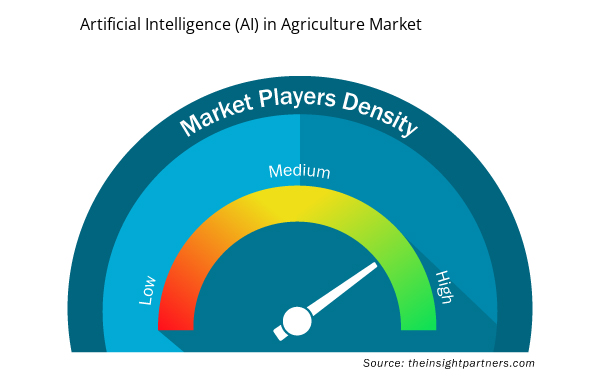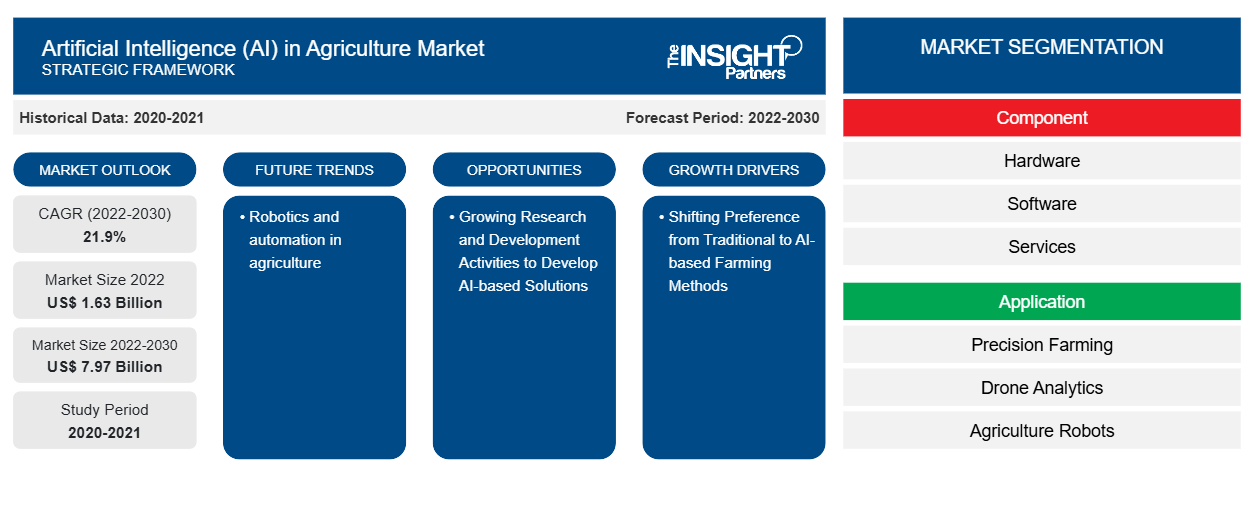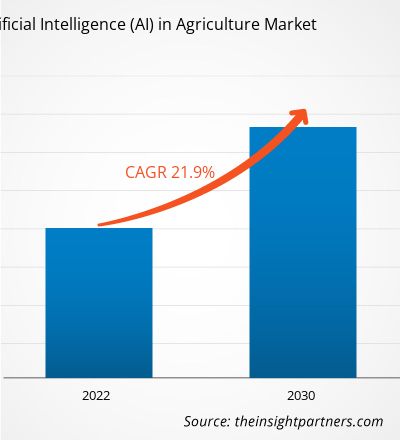2022 年农业人工智能 (AI) 市场规模价值 16.3 亿美元,预计到 2030 年将达到 79.7 亿美元;预计 2022 年至 2030 年的复合年增长率为 21.9%。农业机器人和自动化很可能仍是市场的主要趋势。
农业人工智能(AI)市场分析
从传统农业方法转向人工智能农业方法、无人驾驶飞行器 (UAV) 在农业中的使用日益广泛以及农业对实时分析的需求日益增加,这些因素都在推动市场的发展。由于政府对人工智能解决方案实施的支持日益增加,预计市场在预测期内将实现增长。此外,开发人工智能解决方案的研发活动日益增多,以及智能农业的不断增加,为市场创造了丰厚的利润。
农业人工智能(AI)市场概览
人工智能 (AI) 正在彻底改变农业。预测分析、计算机视觉、机器学习和数据分析正在帮助农业克服障碍并充分发挥其潜力。人工智能在农业中的应用可以从各种来源收集和分析数据,包括土壤条件、天气模式、作物健康状况和历史数据。
基于人工智能的系统可以为农民提供有价值的信息,以提高产量、减少浪费并最大限度地减少环境问题。农民和利益相关者可以利用数据驱动的洞察力和智能决策来提高生产力、优化资源利用和处理农艺问题。智能机械和机器人可用于自动执行农业中的单调任务。这些进步有助于农场解决劳动力短缺问题并专注于战略规划和管理。
定制此报告以满足您的需求
您可以免费定制任何报告,包括本报告的部分内容、国家级分析、Excel 数据包,以及为初创企业和大学提供优惠和折扣
- 获取此报告的关键市场趋势。这个免费样品将包括数据分析,从市场趋势到估计和预测。
农业人工智能 (AI) 市场驱动因素和机遇
从传统农业方法转向基于人工智能的农业方法
加拿大各地的传统马铃薯种植者面临着营养管理方面的挑战,这是农业的一个关键方面,直接影响作物的产量。传统的土壤处理和叶面施肥方法虽然在一定程度上有效,但也存在局限性,尤其是对于马铃薯生长后期所需的营养。因此,加拿大各地的马铃薯种植者正在部署人工智能解决方案来预测马铃薯植株的营养需求。例如,2023 年 11 月,随着农业领域的突破性发展,加拿大马铃薯种植者开始使用人工智能来实时监测和预测作物的营养需求。因此,加拿大农民对人工智能的采用推动了人工智能在农业市场的增长。
不断增加研发活动以开发基于人工智能的解决方案
英国拥有世界一流的技术和研究能力,在开发人工智能解决方案方面处于全球领先地位。此外,英国研究人员正在利用人工智能彻底改变农业等传统行业。根据 2024 年 1 月的数据,哈珀亚当斯大学的研究人员正试图利用人工智能使农业更加可持续和高效。
英国政府还宣布拨款 3982 万美元,支持农业、时尚和应急服务等不同领域的人工智能项目开发。政府还额外拨款 538 万美元,用于对 100 个小型企业项目进行可行性研究,以培育创新的人工智能理念,提高各个领域的生产力。因此,预计这种政府支持将推动农业市场人工智能的发展。
农业人工智能(AI)市场报告细分分析
有助于农业市场分析中人工智能(AI)衍生的关键部分是组件和应用。
- 根据组件,农业人工智能 (AI) 市场分为硬件、软件和服务。硬件部分在 2022 年占据了更大的市场份额。
- 从应用方面来看,市场分为精准农业、无人机分析、农业机器人、牲畜监测等。精准农业领域在 2022 年占据了更大的市场份额。
农业人工智能(AI)市场份额按地区分析
农业人工智能(AI)市场报告的地理范围主要分为五个区域:北美、亚太、欧洲、中东和非洲、南美和中美。
由于对先进技术解决方案的需求不断增长,预计亚太地区的市场将在预测期内扩大。在澳大利亚等农业劳动力迅速老龄化的国家,对熟练劳动力的需求比以往任何时候都大。农业融合了人工智能和机器学习等尖端技术,是缩小这一差距并将农业带入当代的关键。许多澳大利亚农民已经见证了人工智能系统的好处。例如,2023 年 10 月,Wamuran 的 Sunray Strawberries 部署了 DeepBerry 自动监控系统;该系统使用视觉和红外成像来准确检测成熟度、瘀伤、真菌、水果大小、形状和异物。它每小时可以处理超过 7,000 个枪网。这种自动化系统的实施推动了人工智能在农业市场的增长。
农业市场中的人工智能 (AI) 区域洞察
Insight Partners 的分析师详细解释了预测期内影响农业人工智能 (AI) 市场的区域趋势和因素。本节还讨论了农业人工智能 (AI) 市场细分和北美、欧洲、亚太地区、中东和非洲以及南美和中美洲的地理位置。

- 获取农业市场人工智能(AI)的区域特定数据
农业人工智能(AI)市场报告范围
| 报告属性 | 细节 |
|---|---|
| 2022 年市场规模 | 16.3亿美元 |
| 2030 年的市场规模 | 79.7 亿美元 |
| 全球复合年增长率(2022-2030 年) | 21.9% |
| 史料 | 2020-2021 |
| 预测期 | 2022-2030 |
| 涵盖的领域 | 按组件
|
| 覆盖地区和国家 | 北美
|
| 市场领导者和主要公司简介 |
|
农业人工智能 (AI) 市场参与者密度:了解其对业务动态的影响
农业人工智能 (AI) 市场正在快速增长,这得益于终端用户需求的不断增长,这些需求源于消费者偏好的不断变化、技术进步以及对产品优势的认识不断提高等因素。随着需求的增加,企业正在扩大其产品范围,进行创新以满足消费者需求,并利用新兴趋势,从而进一步推动市场增长。
市场参与者密度是指在特定市场或行业内运营的企业或公司的分布情况。它表明在给定市场空间中,相对于其规模或总市场价值,有多少竞争对手(市场参与者)存在。
在农业人工智能(AI)市场运营的主要公司有:
- 途乐科技公司
- PrecisionHawk 公司
- Easytosee Agtech SL
- 迪尔公司
- 气候有限责任公司
- 加玛亚公司
免责声明:上面列出的公司没有按照任何特定顺序排列。

- 了解农业市场人工智能 (AI) 的主要参与者概况
农业人工智能(AI)市场新闻和最新发展
农业市场中的人工智能 (AI) 是通过收集一手和二手研究后的定性和定量数据来评估的,其中包括重要的公司出版物、协会数据和数据库。以下列出了农业市场中人工智能 (AI) 的一些发展:
- Chipotle Mexican Grill 宣布对 Greenfield Robotics 和 Nitricity 进行少数股权投资。Chipotle 的投资将帮助 Greenfield Robotics 扩大其机器人队伍并为其机器人开发更多功能,例如微喷、覆盖作物种植和土壤测试。(来源:Chipotle Mexican Grill,公司网站,2023 年 12 月)
农业人工智能 (AI) 市场报告覆盖范围和交付成果
“农业人工智能 (AI) 市场规模和预测(2020-2030 年)”报告对以下领域进行了详细的市场分析:
- 农业人工智能 (AI) 市场规模及范围涵盖的所有关键细分市场的全球、区域和国家层面预测
- 农业人工智能 (AI) 市场趋势以及市场动态,如驱动因素、限制因素和关键机遇
- 详细的 PEST/波特五力分析和 SWOT 分析
- 农业人工智能 (AI) 市场分析涵盖主要市场趋势、全球和区域框架、主要参与者、法规和最新市场发展
- 行业格局和竞争分析,涵盖市场集中度、热图分析、知名参与者以及农业市场人工智能 (AI) 的最新发展
- 详细的公司简介
- 历史分析(2 年)、基准年、预测(7 年)及复合年增长率
- PEST 和 SWOT 分析
- 市场规模价值/数量 - 全球、区域、国家
- 行业和竞争格局
- Excel 数据集



Report Coverage
Revenue forecast, Company Analysis, Industry landscape, Growth factors, and Trends

Segment Covered
This text is related
to segments covered.

Regional Scope
North America, Europe, Asia Pacific, Middle East & Africa, South & Central America

Country Scope
This text is related
to country scope.
常见问题
Shifting preference from traditional to AI-based farming methods is the major factors that propel the global artificial intelligence (AI) in agriculture market.
North America dominated the artificial intelligence (AI) in agriculture market in 2023.
The global artificial intelligence (AI) in agriculture market is estimated to register a CAGR of 21.9% during the forecast period 2023–2031.
The global artificial intelligence (AI) in agriculture market is expected to reach US$ 9.48 billion by 2031.
Robotics and automation in agriculture to play a significant role in the global artificial intelligence (AI) in agriculture market in the coming years.
The key players holding majority shares in the global artificial intelligence (AI) in agriculture market are Tule Technologies Inc, PrecisionHawk Inc, Easytosee Agtech SL, Deere & Co, Climate LLC, Gamaya SA, International Business Machines Corp, Microsoft Corp, Prospera Technologies Ltd, and Taranis.
Trends and growth analysis reports related to Technology, Media and Telecommunications : READ MORE..
The Insight Partners performs research in 4 major stages: Data Collection & Secondary Research, Primary Research, Data Analysis and Data Triangulation & Final Review.
- Data Collection and Secondary Research:
As a market research and consulting firm operating from a decade, we have published and advised several client across the globe. First step for any study will start with an assessment of currently available data and insights from existing reports. Further, historical and current market information is collected from Investor Presentations, Annual Reports, SEC Filings, etc., and other information related to company’s performance and market positioning are gathered from Paid Databases (Factiva, Hoovers, and Reuters) and various other publications available in public domain.
Several associations trade associates, technical forums, institutes, societies and organization are accessed to gain technical as well as market related insights through their publications such as research papers, blogs and press releases related to the studies are referred to get cues about the market. Further, white papers, journals, magazines, and other news articles published in last 3 years are scrutinized and analyzed to understand the current market trends.
- Primary Research:
The primarily interview analysis comprise of data obtained from industry participants interview and answers to survey questions gathered by in-house primary team.
For primary research, interviews are conducted with industry experts/CEOs/Marketing Managers/VPs/Subject Matter Experts from both demand and supply side to get a 360-degree view of the market. The primary team conducts several interviews based on the complexity of the markets to understand the various market trends and dynamics which makes research more credible and precise.
A typical research interview fulfils the following functions:
- Provides first-hand information on the market size, market trends, growth trends, competitive landscape, and outlook
- Validates and strengthens in-house secondary research findings
- Develops the analysis team’s expertise and market understanding
Primary research involves email interactions and telephone interviews for each market, category, segment, and sub-segment across geographies. The participants who typically take part in such a process include, but are not limited to:
- Industry participants: VPs, business development managers, market intelligence managers and national sales managers
- Outside experts: Valuation experts, research analysts and key opinion leaders specializing in the electronics and semiconductor industry.
Below is the breakup of our primary respondents by company, designation, and region:

Once we receive the confirmation from primary research sources or primary respondents, we finalize the base year market estimation and forecast the data as per the macroeconomic and microeconomic factors assessed during data collection.
- Data Analysis:
Once data is validated through both secondary as well as primary respondents, we finalize the market estimations by hypothesis formulation and factor analysis at regional and country level.
- Macro-Economic Factor Analysis:
We analyse macroeconomic indicators such the gross domestic product (GDP), increase in the demand for goods and services across industries, technological advancement, regional economic growth, governmental policies, the influence of COVID-19, PEST analysis, and other aspects. This analysis aids in setting benchmarks for various nations/regions and approximating market splits. Additionally, the general trend of the aforementioned components aid in determining the market's development possibilities.
- Country Level Data:
Various factors that are especially aligned to the country are taken into account to determine the market size for a certain area and country, including the presence of vendors, such as headquarters and offices, the country's GDP, demand patterns, and industry growth. To comprehend the market dynamics for the nation, a number of growth variables, inhibitors, application areas, and current market trends are researched. The aforementioned elements aid in determining the country's overall market's growth potential.
- Company Profile:
The “Table of Contents” is formulated by listing and analyzing more than 25 - 30 companies operating in the market ecosystem across geographies. However, we profile only 10 companies as a standard practice in our syndicate reports. These 10 companies comprise leading, emerging, and regional players. Nonetheless, our analysis is not restricted to the 10 listed companies, we also analyze other companies present in the market to develop a holistic view and understand the prevailing trends. The “Company Profiles” section in the report covers key facts, business description, products & services, financial information, SWOT analysis, and key developments. The financial information presented is extracted from the annual reports and official documents of the publicly listed companies. Upon collecting the information for the sections of respective companies, we verify them via various primary sources and then compile the data in respective company profiles. The company level information helps us in deriving the base number as well as in forecasting the market size.
- Developing Base Number:
Aggregation of sales statistics (2020-2022) and macro-economic factor, and other secondary and primary research insights are utilized to arrive at base number and related market shares for 2022. The data gaps are identified in this step and relevant market data is analyzed, collected from paid primary interviews or databases. On finalizing the base year market size, forecasts are developed on the basis of macro-economic, industry and market growth factors and company level analysis.
- Data Triangulation and Final Review:
The market findings and base year market size calculations are validated from supply as well as demand side. Demand side validations are based on macro-economic factor analysis and benchmarks for respective regions and countries. In case of supply side validations, revenues of major companies are estimated (in case not available) based on industry benchmark, approximate number of employees, product portfolio, and primary interviews revenues are gathered. Further revenue from target product/service segment is assessed to avoid overshooting of market statistics. In case of heavy deviations between supply and demand side values, all thes steps are repeated to achieve synchronization.
We follow an iterative model, wherein we share our research findings with Subject Matter Experts (SME’s) and Key Opinion Leaders (KOLs) until consensus view of the market is not formulated – this model negates any drastic deviation in the opinions of experts. Only validated and universally acceptable research findings are quoted in our reports.
We have important check points that we use to validate our research findings – which we call – data triangulation, where we validate the information, we generate from secondary sources with primary interviews and then we re-validate with our internal data bases and Subject matter experts. This comprehensive model enables us to deliver high quality, reliable data in shortest possible time.


 获取此报告的免费样本
获取此报告的免费样本